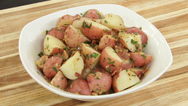Cook's Illustrated: Burgers
- Posted 10.25.12
- NOVA scienceNOW
What's the difference between hamburger meat from the store, and meat you grind at home? Both are composed of short muscle fibers and sticky proteins, but home ground beef allows you control over fat, flavor, and texture. It's the secret to the perfect burger.
Transcript
Cook's Illustrated: Burgers
Posted: October 25, 2012
Cook's Illustrated
The Science of Good Cooking
Concept 14: Grind Meat At Home For Tender Burgers
Dan Souza (Associate Editor, Cook's Illustrated): Ground beef is a staple ingredient in the kitchen. It's easy to find in the supermarket, it's inexpensive, we use in everything from meatballs, to meat sauces, to burgers. So why would you want to grind your own meat at home? Well, before we can answer that question we need to understand some of the science of ground meat.
Beef is composed of long muscle fibers. You can see it here in the grain of this chuck roast. Now, those muscle fibers are surrounded by connective tissue that's tough and holds the meat together. What grinding does is it shears all of those muscle fibers into small pieces that are easy to chew. At the same time they release a sticky protein. And that sticky protein is important because it's what allows us to bind a burger together. Too much however, can lead to a burger that's tough instead of tender. And here's one of the first reasons you really want to grind your own meat at home.
Here I have a pile of store-bought ground beef. As you can see it's very finely ground, it's sticky and pasty. In addition it comes very firmly packed in the package. So what you end up with is tough, dense burgers with a mealy texture. You really have no idea what exactly is going into your ground beef blend. It could be from many different cuts and even different cows.
For comparison I have a pile of beef we ground here in the test kitchen, using nothing more than our freezer and a food processor. As you can see it crumbles through my fingers, has a very loose texture, and it's going to cook up into a burger with a loose, crumbly texture. In addition, because we choose the cuts that go into our beef, we have complete control over fat and flavor.
So now for the fun part. Our taste tests showed burgers made with home-ground beef were indeed more tender than those with store-bought, but we wanted a way to show it. So I've cooked off two burgers, one with home-ground beef, the other with store-bought. Both weighed eight ounces raw. I seared both on both sides, and transferred them to a 300-degree oven to finish cooking. Now, they both rested for five minutes and I'm going to drop a 10 lb dutch oven from six inches up on top of both, and we'll see how much they splatter.
Now, let's take a look at the aftermath. So, you can see that there's a pretty dramatic difference. The burger made with store-bought beef is largely intact. It spilled a little bit of juice, but it didn't really go anywhere on the board. In contrast, the burger made with home ground beef is completely smashed and flattened. Meat flew everywhere.
So, what can we learn from this? Well, by grinding your own meat at home, you have control of the cuts that go into it, so you have control over fat and flavor. You have control over the grind size, and then how tightly the burger is packed. All of that in the end determines how tender and delicious your burger is.
Credits
Production Credits
- Video short produced, photographed, and edited by
- Nick Dakoulas
- Test Kitchen Experiment Editor
- Dan Souza
- Project Editor
- Molly Birnbaum
- Science Editor
- Guy Crosby, Ph.D.
- Editorial Director
- Jack Bishop
- Original Footage and Illustrations
- © America's Test Kitchen 2012
Image
- (burgers)
- © America's Test Kitchen 2012
Related Links
-

Can I Eat That?
Learn about the neuroscience of taste, why we cook our food, what makes a Thanksgiving turkey savory, and more.
-

Cook's Illustrated: Potatoes
All potatoes are not created equal.
-

Food Science: Expert Q&A
Michael Brenner, who teaches a class on the science of cooking, talks about egg whites, ethylene, protein, and more.



